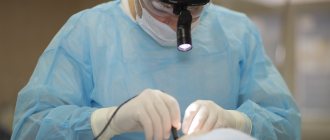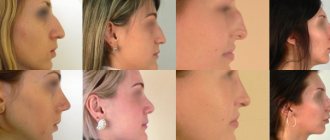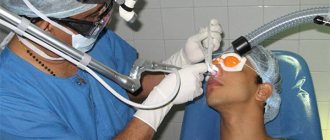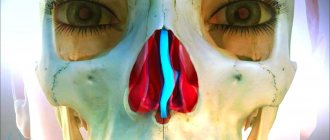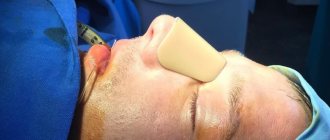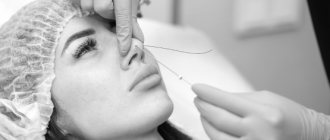Duration
60 minutes
The duration of endoscopic maxillary sinusotomy is 20 minutes.
Soreness
Mild pain
If we are talking about endoscopic maxillary sinusotomy, then this procedure does not involve cutting the lip, the operation is performed through the nose.
Therefore, it is practically painless. Rehabilitation
Required
In the period after surgery, the patient may need tamponade on the operated side for 8-24 hours.
After endoscopic maxillary sinusotomy, it is enough to take painkillers according to the regimen prescribed by the attending physician. It is also necessary to maintain oral hygiene. If inflammation that occurs in the maxillary sinus is not treated in time, you can “earn” such an unpleasant disease as sinusitis, which is manifested by constant nasal congestion, incessant runny nose, headaches in the forehead, and sometimes fever.
1 Examination by an otolaryngologist in MedicCity
2 Examination by an otolaryngologist in MedicCity
3 Examination by an otolaryngologist in MedicCity
In advanced cases of sinusitis and sinusitis, when nasal rinsing and other conservative treatment methods no longer help, maxillary sinusotomy is used.
Maxillary sinus is a surgical operation performed on the maxillary cavity (maxillary sinus) for the purpose of its sanitation, elimination of pathological contents and foreign objects, as well as normalization of nasal breathing. There are classic (radical ) and endoscopic maxillary sinusotomy .
Maxillary sinus is used for severe sinusitis and when foreign bodies enter the maxillary sinus. For sinusotomy, local anesthesia or general anesthesia is most often used.
Causes of a deviated nasal septum
- Genetic factor. This includes any reason why a person has a deviated septum from birth or from a certain point in life without the intervention of external factors. Impairments in fetal development, heredity, poor diet or deficiency of certain microelements - all this can lead to a deviated nasal septum.
- Compensatory reasons. This is the process of the formation of polyps, adenoids, swelling in certain diseases, a consequence of incorrectly done piercing.
- Injuries. One of the most common causes of a deviated nasal septum. It is especially common among athletes and representatives of professions associated with physical labor, among ordinary people after car accidents.
Limitations after sinus lift
The regime of restrictions after surgery is aimed at eliminating the threat of complications and at rapid and effective recovery. The severity and duration of restrictions depends on the complexity of the operation and individual characteristics.
Depending on the type of surgery, there are open and closed sinus lifts. Open (if the bone thickness is less than 7 mm) is more invasive and traumatic, but despite this, the rehabilitation process after a closed sinus lift can be slower and more difficult than with open surgery. It all depends on the specific situation.
The most common postoperative restrictions include abstinence from vigorous physical activity (intense work and sports). You should also postpone air travel, visits to the bathhouse, solarium and other similar events. Severe changes in pressure and temperature can cause bleeding, accumulation of mucus in the maxillary sinuses and other negative consequences.
It is also common to also limit movement of the face, especially the nose and mouth. That is, do not blow your nose, do not sneeze, do not suck in anything forcefully (for example, do not drink a cocktail or juice through a straw), do not puff out your cheeks, do not actively rinse your mouth, etc. Due to sudden movements of the muscles of the mouth or nasopharynx, as well as pressure changes in the oral and nasal cavities, the sutures may come apart and the implanted osteogenic material may become displaced, which is fraught with serious complications.
Indications for surgery to correct the nasal septum
Septoplasty is not performed without indications. To check the condition of the nasal septum, you need to see a doctor and get his opinion. Typically, surgery is prescribed if the patient exhibits the following symptoms for a long time:
- Changes in the shape of the nose - both under the influence of external factors (for example, trauma) and in other cases (genetic changes, a consequence of indolent diseases);
- Sudden and frequent nosebleeds;
- Constantly disturbing rhinitis and sinusitis. And this is a very important symptom - failure to see a doctor in a timely manner can lead to chronic sinusitis and constant migraines;
- Rap during sleep;
- Stopping the functioning of the nostril;
- Frequent allergies;
- Switching to mouth breathing, which worsens the patient’s general condition, as the body ceases to receive sufficient oxygen;
- If two or three symptoms from this list are present, the doctor will prescribe a fluoroscopy, the results of which will help to create an objective picture of the disease. If the image reveals pronounced deformations of the septum, cysts, or aneurysms, preparations for a planned operation are very likely to begin.
What is curvature?
Curvature is the deviation (deviation) of the nasal septum or part of it from the midline. In this case, the deformation may have a C-shape and resemble an arc, or form something like the letter S. In the latter case, the ventilation of both nasal passages will be impaired. Most often, the quadrangular cartilaginous part of the septum, that is, its anterior 2/3, is subject to deviation.
Curvature is also indicated when bone deformations appear in the form of ridges and spines of various shapes, positions and sizes. They are formed from the bony part of the septum, most often from the edge of the vomer. These formations may protrude into the mucous membrane or form additional projections inside the nasal cavity.
Post-traumatic curvatures are usually quite rough, with sharp breaks and tissue displacements. In this case, dislocation of the quadrangular cartilage and a violation of its integrity are often observed.
There are 3 degrees of severity of the curvature of the nasal septum. The first degree is usually not accompanied by obvious clinical signs and is characterized as a minor deformity. And with the third, the bend of the septum almost completely blocks the nasal passage.
Contraindications for septoplasty
There are few contraindications for surgery to correct the nasal septum. This operation cannot be performed:
- Pregnant;
- Nursing mothers;
- Suffering from diabetes;
- Under the age of 16–18 years;
- If you have cancer;
- In some other special cases or at the doctor's discretion.
But even the presence of contraindications does not mean that everything is lost - in this case, the doctor can simply prescribe laser correction.
When is bleeding dangerous?
The risk of massive bleeding during bone grafting is extremely low, since during the preoperative diagnosis the doctor excludes conditions against which this dangerous complication may develop. Therefore, you should not worry about bleeding during a sinus lift or other surgery. Thanks to several decades of experience, modern technologies and drugs, bone grafting is a quick and safe procedure that does not pose a threat to the patient’s life.
However, bleeding may occur later, at home, several days or even weeks after surgery. There are two main pathological conditions in which bleeding may occur after sinus lifting and bone grafting - vessel damage, hypertensive reaction, peri-implantitis and implant rejection.
How is surgery to correct a nasal septum performed?
Before the operation, do not forget to warn the doctor about the presence of chronic diseases, allergies, pills taken and other factors that may in one way or another affect your well-being.
For pain relief during septoplasty, either local anesthesia or general anesthesia is used. During the operation, the surgeon removes part of the septum through the nose that has been deformed. Before this, he moves aside a part of the mucous membrane, which, after correcting the septum, is sewn back into place. After the operation, careful care of the nasal cavity is required. The doctor will give all the necessary recommendations.
At the end of the operation, cotton swabs are inserted into the nose to fix the position of the cartilage. Due to the fact that they cannot be removed during the first three days, the patient has to breathe only through his mouth for some time and consume liquid through a tube in small sips.
Types of maxillary sinusotomy
There are classical (radical) maxillary sinusotomy and endoscopic maxillary sinusotomy.
Radical maxillary sinusotomy
The maxillary sinus operation is used to open the maxillary sinus through the mouth.
Radical maxillary sinusotomy is carried out using local or general (as indicated) anesthesia and includes the creation of access, excision of soft tissue, opening of the maxillary cavity and removal of polyps or foreign objects, formation of an anastomosis connecting the maxillary sinus with the lower nasal passage. The operation takes about an hour.
1 Radical maxillary sinusotomy in MedicCity
2 Radical maxillary sinusotomy in MedicCity
3 Radical maxillary sinusotomy in MedicCity
The essence of the operation
With an intraoral gairotomy, the otolaryngologist makes a horizontal incision in the soft tissues of the upper gum and moves them upward. Then, using special instruments, part of the bone plate on the facial wall of the maxillary sinus is removed. Thanks to the hole made, the sinus cavity becomes accessible for manipulation, and the otolaryngologist removes the pathological contents using a sharp spoon.
After scraping the mucous membrane, an anastomosis is formed with the nasal cavity, smoothing out the bone defect. A flap is made from the remaining free mucosa and placed on the bottom of the maxillary sinus to restore epithelization of its walls.
At the end of the operation, a tampon is placed in the sinus, which is removed into the nasal passage, and the wound on the side of the mouth is sutured. Using a tampon, sterility of the sinus is achieved and the accumulation of blood and pus is prevented.
After 48 hours, after preliminary anesthesia, the tampon is removed, and the patient is prescribed vasoconstrictor drops and sinus lavage. After a week, the sutures in the mouth are removed.
Endoscopic maxillary sinusotomy
Endoscopic maxillary sinusotomy is very popular as a minimally invasive and more gentle technique. With endoscopic maxillary sinusotomy, the lip is not dissected; the operation is performed through the nose. The procedure is virtually painless, characterized by minor swelling after surgery and does not leave scars.
Endoscopic maxillary sinusotomy. Its advantage over conventional surgery:
- low morbidity;
- minimal blood loss;
- the ability to perform surgery on an outpatient basis;
- quick rehabilitation period for the patient;
- absence of cosmetic defect after surgery.
The essence of endoscopic maxillary sinusotomy
This type of operation is performed under local anesthesia using special endoscopic equipment through the nose.
The indication for endoscopic maxillary sinus, as well as for conventional surgery, is a severe purulent process in the maxillary sinus, for which conservative treatment has proven ineffective.
The duration of endoscopic maxillary sinusotomy is 20 minutes. The opening of the maxillary cavity occurs through the nose, and not an incision is made, but a minimal puncture with a diameter of about 5 mm. An endoscopic tube is inserted into this incision, and foreign objects and pathogenic material are removed using suction. All manipulations are performed under the control of an endoscope.
The following methods of endoscopic access to the maxillary cavity exist:
- through the middle nasal meatus;
- through the lower nasal passage;
- through the anterior stack of the sinus;
- through the alveolus of the tooth (if there is a fistula);
- through the tubercle of the maxilla.
1 Diagnosis of sore throat
2 Diagnosis of sore throat
3 Diagnosis of sore throat
The use of endoscopic maxillary sinusotomy helps reduce trauma to surrounding tissues and speed up rehabilitation after surgery.
With the help of endoscopic maxillary sinusotomy, it is possible to avoid the feeling of numbness in the teeth on the operated side, which the patient experiences during a conventional operation.
Highly qualified otolaryngologists of the Multidisciplinary Clinic "MedicCity" will help you in solving various ENT problems. We possess all modern methods of diagnosing and treating diseases of the ear, nose and throat.
Postoperative care
After the operation, sanitation is required - that is, rinsing the nasal cavity. The first time, the surgeon does this, and after that the patient can cope quite well on his own. The number of sanitation depends on the body: for some, healing occurs quickly and two or three procedures are enough, while for others it may take a month of rinsing.
At first, you should not blow your nose too much, as any excess irritation may cause blood to flow. The nose will dry out very much for some time, so it will be necessary to regularly carefully clean it of crusts and lubricate it with ointment.
Modern sutures are not removed, which immediately saves the patient from an unnecessary and unpleasant procedure. Inpatient treatment lasts no more than three days, then the patient is examined on an outpatient basis.
Rehabilitation after maxillary sinusotomy
In the period after surgery, the patient may need tamponade on the operated side for 8-24 hours. After endoscopic maxillary sinusotomy, it is enough to take painkillers according to the regimen prescribed by the attending physician.
It is necessary to maintain oral hygiene: brush your teeth, gargle with antiseptics and follow all consultations with your doctor.
After studying the reviews about sinusotomy, you can understand whether maxillary sinusotomy is right for you. The price depends on the choice of operation.
3. Symptoms and diagnosis
In most cases, the hematoma is localized between the quadrangular cartilage and the perichondrium. As shown above, this situation is rarely isolated, so it is relatively difficult to identify symptoms specific to hematoma. As a rule, patients complain of difficulty in nasal breathing, a feeling of heaviness, a feeling of a bursting or “iridescent” foreign body, decreased olfactory sensitivity, an outwardly noticeable deformation of the nose, sometimes with a purplish-red tint to the skin. With mild pain and general discomfort, many patients prefer not to seek medical help - and make a mistake, since any injuries and hematomas in the nasopharynx, given the characteristics of this area, become extremely easily infected. A sharp intensification of pain, its pulsating nature, a progressive deterioration of the general condition with signs of intoxication (headache, chills, nausea, lack of appetite, weakness, etc.) are signs of infection and the onset of an abscessing purulent-inflammatory process, which in turn can lead to to very serious complications, given the proximity of the brain, organs of hearing and vision, entrances to the digestive and respiratory tracts, as well as the abundance of nerves, lymph nodes, blood vessels and mucous membranes.
Diagnostics includes the collection of anamnestic information and complaints, standard rhinoscopy (examination of the septum using a dilator). As diagnostic needs arise, laboratory and instrumental tests are prescribed - usually radiography, CT, and sometimes puncture of the contents.
About our clinic Chistye Prudy metro station Medintercom page!
1.General information
Hematoma is a tumor-like accumulation of blood that has spilled into a limited space or cavity due to damage to blood vessels. The caliber of the affected vessels and, accordingly, the volume of the hematoma can vary significantly. There are also various options for the content of a hematoma (fresh or coagulated blood, admixtures of lymph, pus, etc.), its localization, further development and outcome: most often, a hematoma, for example, subcutaneous, gradually resolves during natural protective and restorative processes, but in some cases, the threat of suppuration or mechanical pressure on vital organs forces emergency surgical intervention.
Hematoma of the nasal septum is a common phenomenon in otorhinolaryngological practice, but the first to observe it are, as a rule, traumatologists. For obvious reasons (see below), hematoma of this localization is most common among representatives of that gender group that is so proud of the name “stronger sex” - and likes to confirm this with action.
A must read! Help with treatment and hospitalization!
Hypertensive reaction
In cases of sinus lift surgery performed on a patient with hypertension, there is always the possibility of a delayed increase in pressure when the patient returns home or after 12 hours. To prevent such reactions, our in-house anesthesiologist performs preparation and surgery in a state of light sedation to exclude a psycho-emotional reaction with an increase in pressure during treatment and 24 hours later. Combo sedation guarantees 100% delayed hypertensive surges in the anesthesiology department.
Using Aqualor spray after surgery in the nasal cavity
The main component of the Aqualor product line is purified sea water from the Atlantic Ocean. Special technology allows you to maintain beneficial properties throughout the entire shelf life. A convenient sprayer allows you to apply the solution to the mucous membrane evenly and delicately.
The isotonic solution Aqualor Soft moisturizes the mucous membrane well, relieves itching and prevents the appearance of cracks. Improves the fluidity of discharge, making it easier to blow your nose.
Using Aqualor after septoplasty every 3-4 hours helps prevent the hardening of blood crusts. Dried crusts, in addition to discomfort, create the risk of bedsores on the mucous membrane and even perforation of the nasal septum.
After surgery, swelling occurs at the site of injury, patients complain of a complete inability to breathe through their nose. The use of Aqualor Soft gently restores nasal breathing, most patients note a positive effect.
But if the isotonic solution Aqualor Soft was not effective enough, Aqualor Forte with a hypertonic salt concentration will come to the rescue. It is important that both solutions can be used without restrictions, since they do not dry out the mucous membrane and are not addictive, unlike vasoconstrictors.
Aqualor Protect with brown algae extract accelerates wound healing and provides additional antimicrobial protection due to the high iodine content in the composition. It is this drug that increases the activity of immune cells of macrophages. These cells are localized at the site of inflammation, absorb foreign particles, microorganisms, decay products, dead cells of their own body - everything that can cause suppuration.
Aqualor sprays for rhinoplasty should be used from the second day after surgery.
All 3 items are easy to use and suitable for home use. The drug does not have a systemic effect.
2. Reasons
The vast majority of hematomas of the nasal septum are of traumatic origin - up to 90% of cases. As a rule, the immediate cause is a blow to the nose (which very rarely turns out to be the only and isolated etiological factor; more often such a hematoma is observed as an element of a complex multiple maxillofacial and craniocerebral injury) or an uncontrolled fall face down. Another approximately 5% are iatrogenic hematomas, i.e. caused by medical procedures or surgery in this area.
Other, much rarer causes include various hematological and infectious diseases that cause thinning, fragility, increased permeability of vascular walls and/or decreased blood clotting, especially if such a pathology occurs against the background of hypovitaminosis or hypertension.
Visit our Otolaryngology (ENT) page
